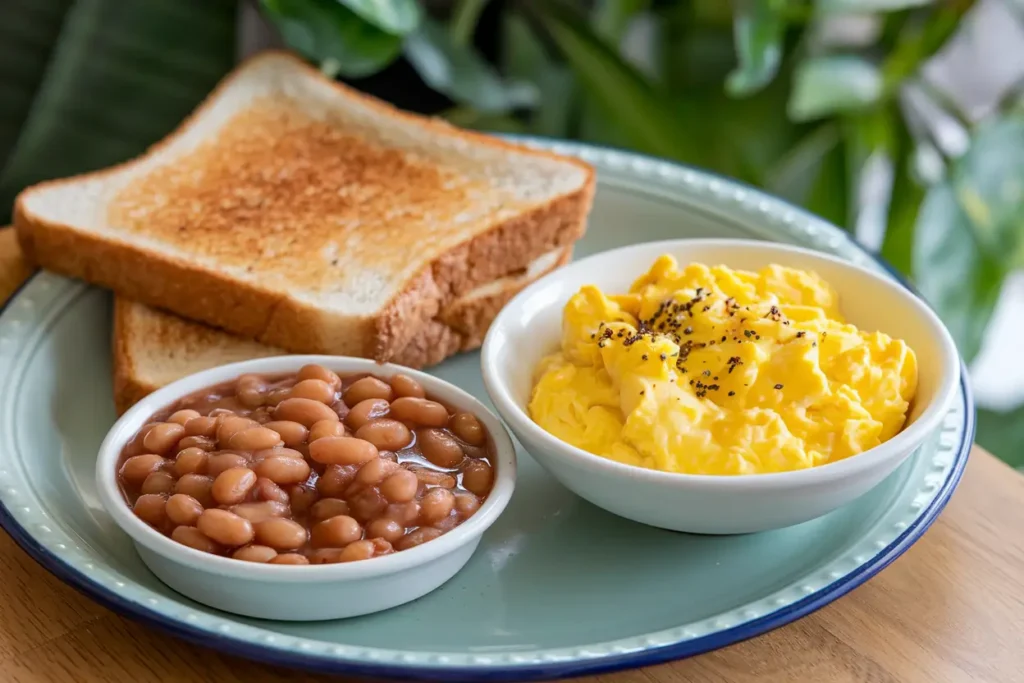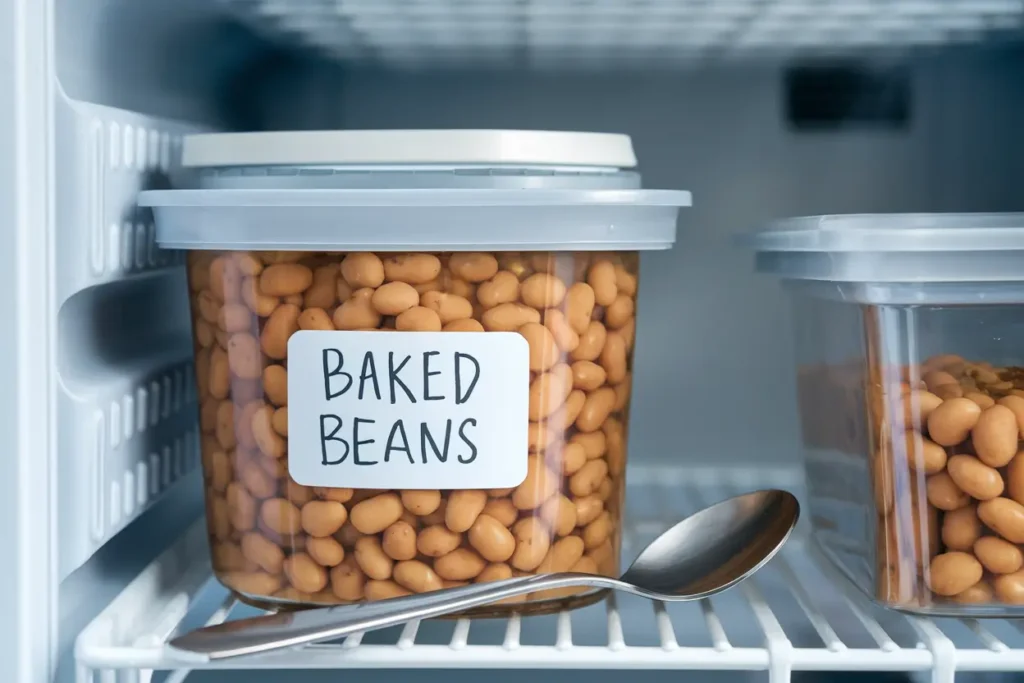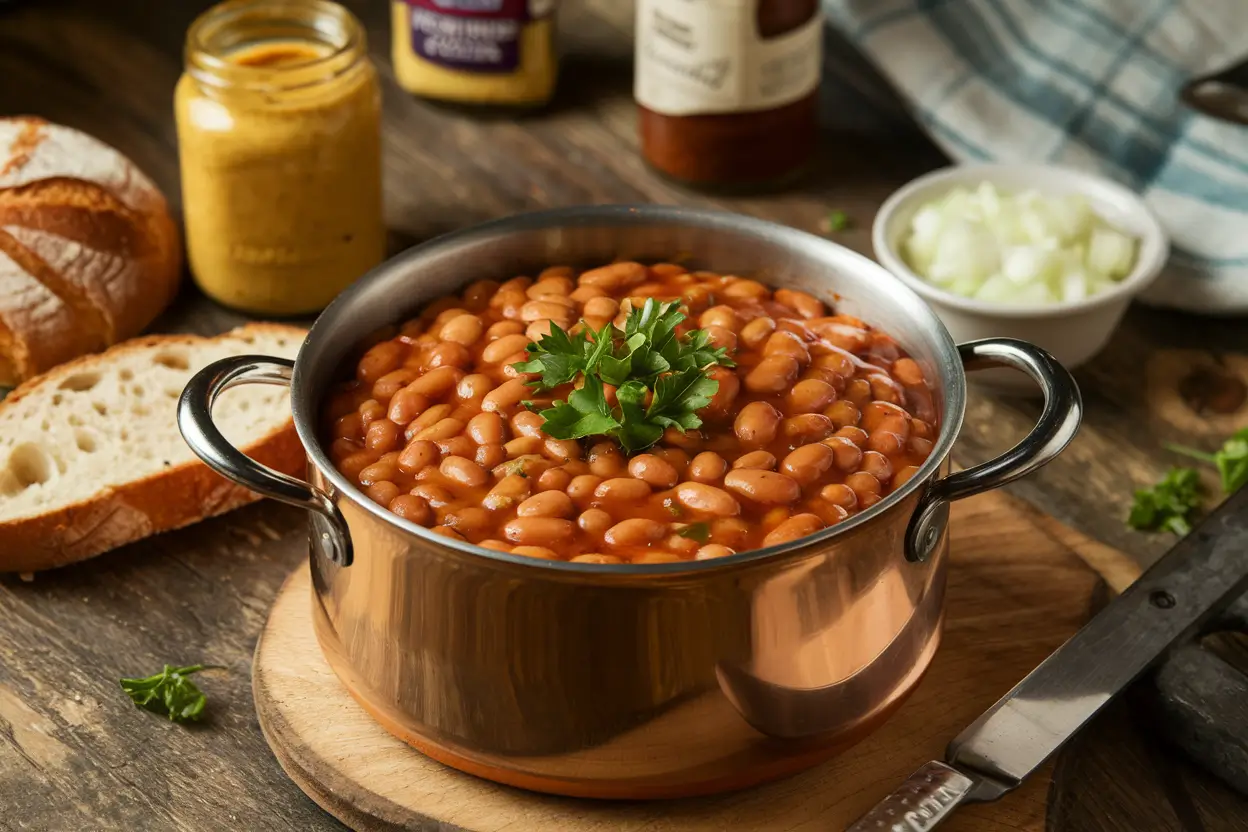Table of Contents
Introduction to Baked Beans: A Timeless Dish
Why Baked Beans Are a Comfort Food Favorite
This baked beans recipe is truly the ultimate comfort food, making it perfect for any occasion. For generations, baked beans have been a staple in kitchens around the world. Not only are they beloved for their comforting flavor, but they are also celebrated for their incredible versatility.
The Many Ways to Enjoy Baked Beans
For instance, baked beans can be served at a summer barbecue, paired with a hearty breakfast, or included as a side dish during holidays. In each case, baked beans consistently bring people together with their rich taste and satisfying texture.
What Makes Baked Beans Recipe
So Special?
So, have you ever wondered what makes baked beans stand out from other dishes? If yes, then let’s dive into the secrets behind the perfect baked beans recipe.
Why You’ll Love This Baked Beans Recipe?
The History of Baked Beans: From Tradition to Trend
Nutritional Value of Baked Beans Recipe
Baked beans are not just tasty—they’re also incredibly nutritious. For starters, they are packed with protein, fiber, and essential minerals like iron and magnesium, making them a well-rounded addition to any meal. That said, it’s important to watch out for high sugar and sodium content in some store-bought varieties. By being mindful of this, you can enjoy all the benefits of baked beans without compromising your health.
“Did you know? Homemade baked beans can be tailored to your taste and dietary preferences, making them even more enjoyable and healthier!”
How to Perfect Your Baked Beans Recipe Every Time?

Key Components: Beans, Sauce, and Seasonings
The magic of baked beans lies in their simplicity. Here’s what you need:
- Beans: Navy beans or cannellini beans work best for their creamy texture.
- Sauce: A mix of tomato paste, molasses, brown sugar, and mustard creates the signature flavor.
- Seasonings: Smoked paprika, garlic, onion, and a pinch of salt bring everything together.
Choosing the Best Beans for Your Recipe
Dried beans provide a superior texture and flavor compared to canned beans. However, canned beans are undeniably more convenient. If you choose to use dried beans, it’s essential to soak them overnight. This simple step not only reduces cooking time but also ensures even cooking, giving you perfectly tender beans every time.
Alternative Ingredients for Unique Variations
Looking to switch things up? For a tangy twist, add a splash of apple cider vinegar. Alternatively, if you’re craving some heat, throw in diced jalapeños for a spicy kick. If you’re vegetarian, you can easily substitute bacon with smoked tofu or a dash of liquid smoke to achieve that hearty, smoky flavor.
Step-by-Step Guide to Making Classic Baked Beans Recipe
Preparation Time and Required Tools
- Prep Time: 20 minutes
- Cook Time: 2–3 hours (depending on the method)
- Tools Needed: A Dutch oven, mixing bowls, measuring spoons, and a sturdy spoon for stirring.
Cooking Methods: Oven, Stovetop, or Slow Cooker
- Oven: Preheat your oven to 350°F (175°C). Combine your ingredients in a Dutch oven, cover, and bake for 2–3 hours.
- Stovetop: Simmer the beans on low heat, stirring occasionally to avoid sticking.
- Slow Cooker: Combine everything and cook on low for 6–8 hours or high for 3–4 hours.
Recipe Variations for Special Diets
- Vegan Baked Beans Recipe: Use plant-based substitutes like tempeh or coconut aminos.
- Low-Sugar Baked Beans Recipe: Replace brown sugar with a natural sweetener like honey or stevia.
- Gluten-Free Baked Beans Recipe: Double-check all sauces and seasonings to ensure they’re gluten-free.
Common Problems in Cooking Baked Beans Recipe and Solutions
1. Overcooked or Undercooked Beans
Problem:
Beans that are overcooked often turn mushy and lose their shape, while undercooked beans on the other hand remain tough and unappetizing. As a result, this inconsistency can ruin the texture and overall enjoyment of the dish.
Solution:
To begin with, test the beans periodically during the cooking process to avoid overcooking or undercooking them. For dried beans, ensure they are soaked overnight, as this step reduces cooking time and promotes even cooking. When simmering, keep the heat at a steady, low temperature. Otherwise, high heat can cause the beans to cook unevenly, with the outer layers becoming too soft while the centers remain firm.
Additionally, if you’re using a pressure cooker, follow the recommended cooking times closely, because beans can overcook quickly in high-pressure environments. Meanwhile, for canned beans, remember they are already cooked, so they only need to be heated through to absorb the flavors of the sauce.
2. Adjusting the Sweetness or Tanginess
Problem:
Sometimes, the flavor balance is off, with the beans tasting either too sweet or lacking the tangy kick that makes them delicious. As a result, the dish may not achieve its desired taste.
Solution:
To address excessive sweetness, add a splash of acidic ingredients like apple cider vinegar, white vinegar, or freshly squeezed lemon juice. Not only do these ingredients counterbalance the sweetness, but they also add depth to the overall flavor profile, enhancing the dish’s complexity.
On the other hand, if your baked beans lack sweetness, you can enhance the flavor with natural sweeteners like maple syrup, honey, or a bit of brown sugar. However, it’s important to add these gradually, tasting as you go to avoid over-sweetening. For a more complex flavor, consider using molasses, which provides both sweetness and a rich, slightly bitter undertone that complements the beans beautifully.
3. Avoiding Watery or Too Thick Consistency
Problem:
A watery sauce leaves the beans swimming in liquid, which can make the dish feel incomplete. Conversely, a sauce that’s too thick can feel cloying and may not coat the beans evenly. In either case, the consistency of the sauce is critical to the overall success of the dish.
Solution:
To fix a watery sauce, simmer the beans uncovered on low heat for 10–15 minutes. This way, the excess moisture evaporates, leaving behind a rich, well-coated dish. While doing so, stir occasionally to prevent burning at the bottom of the pan.
On the other hand, if the sauce is too thick, thin it out by gradually adding a splash of water, broth, or tomato juice while stirring. Be sure to adjust the liquid in small increments to avoid making the sauce runny again.
For a creamier consistency, consider mashing a small portion of the beans and stirring them back into the dish. Not only does this technique thicken the sauce naturally, but it also enhances the overall texture, giving the dish a velvety finish
Pro Tip: Always taste-test your baked beans throughout the cooking process to ensure the balance of flavors and consistency is just right. Making small adjustments along the way is the key to perfection.
Delicious Ways to Serve Baked Beans Recipe

Pairing Baked Beans with Breakfast, Lunch, or Dinner
- Breakfast: Serve alongside scrambled eggs and toast.
- Lunch: Add baked beans to a baked potato for a filling meal.
- Dinner: Pair with grilled meats or roasted vegetables for a hearty plate.
Creative Toppings to Elevate Your Dish
To enhance both flavor and presentation, sprinkle grated cheese, crispy bacon bits, or fresh herbs like parsley over your baked beans. Not only do these toppings add visual appeal, but they also elevate the taste of the dish to the next level
Storing and Reheating Baked Beans Recipe: Tips and Tricks

Freezing for Long-Term Storage
Got leftovers? Baked beans freeze beautifully!
- How to Freeze: Allow the beans to cool completely, then transfer them into airtight containers or freezer bags. Label them with the date for easy tracking.
- Shelf Life: Properly stored, baked beans can last up to three months in the freezer.
Best Practices for Reheating Without Losing Flavor
- Microwave: Place a portion in a microwave-safe bowl, cover, and heat on medium power in short bursts, stirring in between.
- Stovetop: Add a splash of water or broth to prevent drying, and heat gently over low heat while stirring occasionally.
- Oven: Reheat in a covered dish at 300°F (150°C) until warmed through.
“Pro Tip: Reheating Baked Beans Recipe on the stovetop with a drizzle of olive oil can revive their creamy texture and enhance their flavor.”
Health Benefits and Misconceptions About Baked Beans Recipe
High Protein and Fiber Content
Baked beans are an excellent source of plant-based protein, making them a great meat substitute for vegetarians. They’re also rich in dietary fiber, promoting healthy digestion and keeping you feeling full longer.
Addressing Concerns About Sugar and Sodium
Store-bought baked beans often contain added sugars and sodium. By making them at home, you can control these elements, creating a dish that aligns with your health goals without compromising on taste.
“Did you know? Adding natural sweeteners like maple syrup or honey to your homemade baked beans can cut down on refined sugar intake.”
Frequently Asked Questions About Baked Beans Recipes
1. Can I Use Canned Beans for This Recipe?
Yes! Canned beans save time and work well. However, be sure to rinse and drain them first to remove excess sodium before cooking.
2. What Are the Best Substitutes for Bacon in the Recipe?
Smoked tofu, tempeh, or even liquid smoke provide a similar smoky flavor. Additionally, for added texture, try roasted mushrooms.
3. How Can I Make My Baked Beans Spicier?
To add heat, try diced jalapeños, a dash of cayenne pepper, or a few drops of hot sauce for a fiery twist.
4. Are Baked Beans Suitable for Vegans?
Absolutely! Skip the bacon and ensure that any additional ingredients, like Worcestershire sauce, are vegan-friendly. This way, the recipe remains 100% plant-based.
5. Can I Make Baked Beans Ahead of Time?
Yes, baked beans taste even better the next day as the flavors meld. For the best results, prepare them a day in advance and reheat gently before serving.
6. How Do I Prevent Baked Beans from Becoming Too Dry?
While cooking, keep an eye on the liquid level. If they seem dry, add small amounts of water, broth, or tomato sauce as needed.
7. Can I Make Baked Beans Without Sugar?
Yes, you can! Instead of sugar, use naturally sweet ingredients like caramelized onions, carrots, or pureed roasted sweet potatoes to enhance the flavor without added sugars.
8. How Do I Avoid a Metallic Taste in Baked Beans Recipe?
A metallic taste can occur if acidic ingredients like tomatoes are cooked in reactive cookware (like aluminum). To prevent this, use non-reactive cookware such as stainless steel or enameled cast iron.
9. Can I Cook Baked Beans Faster Without Compromising Flavor?
To save time, use canned beans and cook the dish in a pressure cooker. By doing so, you can significantly reduce cooking time while still infusing the beans with rich flavor.
10. What’s the Best Way to Make Baked Beans Creamier?
For a creamier texture, mash a small portion of the beans and stir them back into the pot. Alternatively, adding a splash of heavy cream or coconut milk can make the dish richer.
11. Can I Make Baked Beans in Advance for a Party?
Absolutely! Baked beans are an excellent make-ahead dish. To ensure freshness, cook them a day or two before the event, store them in the refrigerator, and reheat them in the oven or slow cooker on the day of the party.
12. Are Baked Beans Safe for Kids?
Yes, baked beans are a nutritious choice for children. To make them more kid-friendly, reduce the amount of spices or chili for a milder flavor.
13. How Can I Prevent My Baked Beans from Burning?
To avoid burning, stir the beans occasionally during cooking, especially if using the stovetop method. Furthermore, adding a splash of liquid if the mixture looks dry can help prevent sticking.
14. What’s the Ideal Cooking Time for Dried Beans?
Dried beans typically need 1–2 hours of simmering after soaking. However, cooking times can vary depending on the type of bean and its age. Therefore, always taste-test for doneness.
15. Can I Add Vegetables to My Baked Beans Recipe?
Yes! Diced bell peppers, onions, tomatoes, or even shredded zucchini can be added for extra flavor and nutrition. For best results, sauté them before adding to the pot..
Conclusion: Why You Should Try This Baked Beans Recipe Today
Baked beans are more than just a side dish—they’re a culinary classic that’s not only versatile but also nutritious and deeply comforting. With this in mind, this ultimate recipe allows you to create a dish that’s bursting with flavor and tailored to your preferences. For instance, whether you’re hosting a barbecue, preparing a family meal, or simply indulging in some comfort food, baked beans are undoubtedly a surefire crowd-pleaser.
So, roll up your sleeves and start cooking! Before long, your kitchen will smell incredible, and your taste buds will thank you. 😊
For more Recipes:
1️⃣ Want more tasty ground beef recipes? Check out these Mouthwatering Ground Beef Recipes for more meal ideas!
2️⃣ Looking for another quick and hearty meal? Try this Salisbury Steak Recipe – Easy & Hearty for a comforting, homemade dinner!


4 thoughts on “Baked Beans Recipe: Comfort Food You’ll Crave”